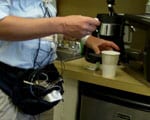Election as a National Academy of Inventors fellow is the highest professional honor given to academic inventors.
Dallas Innovates covered the naming of Bobby B. Lyle School of Engineering Professor Bruce Gnade as a Fellow to the National Academy of Inventors.
Journalist Lance Murray noted that SMU’s Gnade holds 77 U.S. patents and 55 foreign patents, and is the author or co-author of more than 195 refereed journal articles. Currently, his research focuses on flexible electronics with applications ranging from radiation sensors to microelectronic arrays for cellular recording.
The Dallas Innovates article, “SMU, UTA Profs Named National Academy of Inventors Fellows,” published Dec. 12, 2017.
EXCERPT:
By Lance Murray
Dallas Innovates
Bruce Gnade, executive director of the Hart Center for Engineering Leadership and clinical professor within Southern Methodist University’s Bobby B. Lyle School of Engineering, and Dereje Agonafer, Jenkins Garrett professor in mechanical and aerospace engineering at the University of Texas at Arlington received the honors.The professors were included in a group of 155 fellows nationwide named Tuesday by the academy.
Election as NAI Fellow is given to academic inventors who have shown a spirit of innovation in creating or facilitating inventions that have made a tangible impact on quality of life, economic development, and welfare of society.
NAI fellows are named as inventors on U.S. patents, and are nominated by their peers based on their contributions to innovation in areas such as patents and licensing, innovative discovery and technology, significant impact on society, and support and enhancement of innovation.
PROFS’ WORK COVERS FLEXIBLE ELECTRONICS, SEMICONDUCTOR RESEARCH
SMU’s Gnade holds 77 U.S. patents and 55 foreign patents, and is the author or co-author of more than 195 refereed journal articles. Currently, his research focuses on flexible electronics with applications ranging from radiation sensors to microelectronic arrays for cellular recording, according to SMU.Prior to joining SMU, Gnade held leadership positions at Texas Instruments and the Defense Advanced Research Projects Agency, where he served as a program manager overseeing influential technology research projects for the Department of Defense. He is currently serving on the Board of Directors of Oak Ridge Associated Universities.
His academic career includes faculty appointments at the University of Maryland, the University of North Texas, and the University of Texas at Dallas.
Gnade is a member of the Materials Research Society and the Society for Information Display, a senior member of the Institute of Electrical and Electronics Engineers, and a fellow of the American Physical Society.





